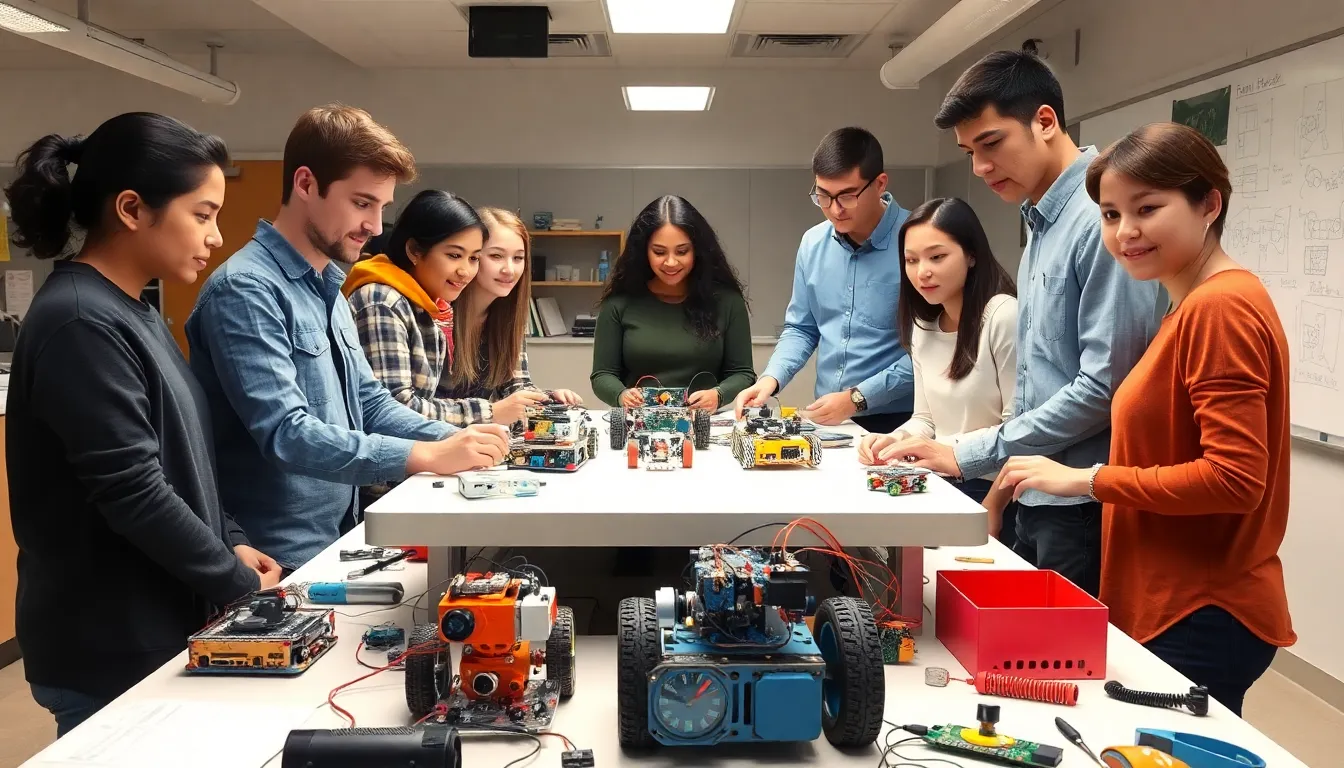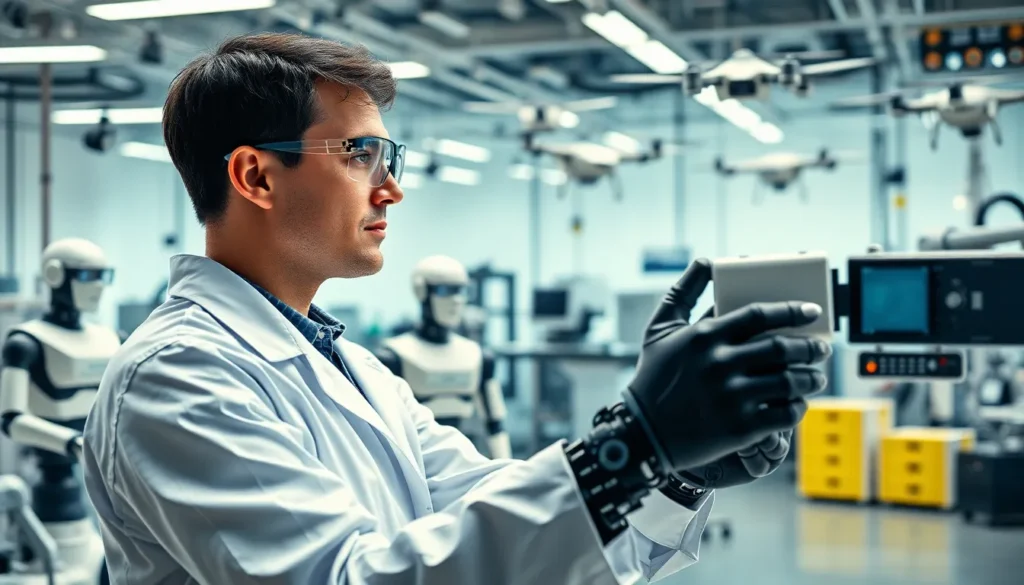In a world where robots can make coffee and vacuum floors, the robotics lab stands as a playground for innovation and creativity. Imagine a place where brilliant minds tinker with circuits and coding, turning wild ideas into reality. It’s not just about building machines; it’s about crafting the future, one quirky robot at a time.
From humanoids that can dance better than your uncle at weddings to drones that might just deliver your pizza, robotics labs are where the magic happens. These hubs of technology are transforming industries and redefining what’s possible. So, whether you’re a tech enthusiast or just someone who thinks robots could use a little more personality, stepping into a robotics lab is like entering a sci-fi movie—minus the aliens (for now).
Table of Contents
ToggleOverview of Robotics Labs
Robotics labs serve as dynamic environments where innovation and experimentation thrive. In these spaces, engineers and researchers collaborate to design, develop, and test advanced robotic systems. Complex projects often include autonomous vehicles, drones, and robotic arms, showcasing the versatility of robotics technology.
Scientists leverage cutting-edge tools in robotics labs, utilizing software programming, artificial intelligence, and machine learning. Specific technologies play a crucial role in enhancing the efficiency and functionality of robotic systems. Engineers examine how sensors and actuators work together, creating responsive and adaptable machines.
Collaboration occurs frequently within robotics labs. Students, professionals, and hobbyists come together to share knowledge and skills. Workshops often provide hands-on experience, fostering a community of enthusiasts eager to explore robotics.
Educational institutions emphasize the importance of robotics labs in training the next generation of engineers. Curriculums incorporate real-world applications, ensuring students grasp essential concepts. Research and development initiatives drive breakthroughs in robotics, contributing to advancements in healthcare, manufacturing, and logistics.
These labs represent a convergence of diverse fields including engineering, computer science, and design. Multidisciplinary approaches enable teams to tackle complex challenges effectively. The vibrant atmosphere encourages creativity, inspiring projects that envision the future of automation and robotics.
Robotics labs encapsulate a revolutionary spirit. They provide critical insights into how robotics can transform everyday life and drive industry progress. Engaging both novices and experts, these labs exemplify the endless possibilities within the realm of robotics.
Types of Robotics Labs

Robotics labs come in various forms, each contributing uniquely to the field. Understanding the different types allows for better appreciation of their roles in innovation and development.
Academic Robotics Labs
Academic robotics labs primarily focus on research and education. These labs offer students hands-on experience with robotics technologies. Universities often provide resources for developing innovative projects. Research conducted here typically addresses fundamental questions in robotics and engineering. Collaboration between faculty and students leads to breakthroughs in artificial intelligence and machine learning. Many projects showcase prototypes that can eventually influence real-world applications. Educational outcomes are enhanced by competitions and conferences that stimulate further interest in robotics.
Industrial Robotics Labs
Industrial robotics labs prioritize practical applications in manufacturing and automation. These environments support the development of robotic systems that improve efficiency and productivity. Engineers design and test robots that can handle tasks like assembly and quality control. Many companies use these labs to prototype and refine their robotic solutions. Integration of automation into production lines often results in lower costs and higher output. Real-time data analysis from these labs allows for ongoing improvements in design and performance. Working in sync with production goals, these labs represent a crucial step in advancing industrial capabilities.
Key Technologies in Robotics Labs
Robotics labs utilize various technologies to enhance their innovative potential. Two major components in these labs are artificial intelligence and machine learning.
Artificial Intelligence
Artificial intelligence powers robotic systems by enabling them to simulate human-like decision-making. It allows robots to analyze their environments and execute tasks autonomously. For instance, AI algorithms help drones navigate complex terrains and avoid obstacles. Moreover, natural language processing components enhance human-robot interaction. Robots equipped with AI can perform tasks spanning from industrial automation to personal assistance, thus showcasing their versatility. Projects in academic labs frequently leverage AI to advance research and develop applications capable of addressing real-world challenges.
Machine Learning
Machine learning strengthens robotics by facilitating systems that learn from data. Robots optimize their functionalities by analyzing patterns in previous experiences. Training models with extensive datasets enables robots to improve their accuracy over time. For example, robotic arms utilize machine learning to refine their grip strength based on varying object weights. Additionally, this technology assists in predictive maintenance by identifying potential failures before they occur. Through these capabilities, machine learning significantly contributes to enhancing the efficiency and reliability of robotic systems across different industries.
Applications of Robotics Labs
Robotics labs play a crucial role in advancing technology across various fields. Their applications range from fundamental research to specialized industry practices.
Research and Development
Research teams use robotics labs to push the boundaries of innovation. Engineers prototype new robotic systems, testing their capabilities and functionalities. Development of autonomous vehicles stands out as one significant area where labs contribute. Collaborations between academic institutions and industry experts foster creativity and facilitate groundbreaking discoveries. Projects often address complex scientific questions, driving advancements in artificial intelligence and machine learning. Additionally, interdisciplinary teams explore the integration of different technologies, improving overall performance in robotic systems. Each project leads to unique insights, paving the way for real-world applications and future developments.
Industry-Specific Applications
The impact of robotics labs extends to various industries, enhancing efficiency and effectiveness. Manufacturing sectors benefit from automation solutions that robots provide. Assembly lines utilize robotic arms for precision tasks, reducing human error and increasing output. Healthcare sectors also see advancements, particularly in surgical robots that assist surgeons with enhanced dexterity. Agriculture benefits from automated farming equipment, which optimizes planting and harvesting processes. In logistics, drones and automated vehicles streamline delivery systems, ensuring faster and more reliable service. Each industry leverages the capabilities developed in robotics labs, driving productivity and shaping the future of work environments.
Future Trends in Robotics Labs
Innovative technologies shape the future landscape of robotics labs. Increased integration of artificial intelligence enhances robotic capabilities, enabling machines to adapt to complex environments and improve task execution. Collaborative robotics, or cobots, foster seamless interaction between humans and robots, allowing for efficient human-robot teamwork in various industries.
Sustainability stands as a key focus within robotics labs. Researchers explore eco-friendly materials and energy sources, prioritizing green technologies in robotic design and manufacturing processes. This shift not only reduces environmental impact but also addresses industry demand for sustainable solutions.
Advancements in soft robotics open new possibilities for gentle manipulation of delicate objects. These robots use flexible materials to navigate nuanced tasks, beneficial in sectors such as healthcare and agriculture. By enabling precision handling, soft robotics paves the way for innovative applications and growth in emerging markets.
The rise of 5G technology facilitates better communication between robotic systems. Enhanced connectivity improves real-time data exchange, supporting autonomous vehicles and remote operations. With higher bandwidth and lower latency, robotics labs effectively implement smart solutions that rely on instantaneous communication.
Automated testing and simulation tools enhance the design process within robotics labs. These advanced tools allow researchers to model scenarios and test robotic systems virtually, reducing development time and costs. As simulations become increasingly realistic, they support iterative improvements and rapid prototyping.
The incorporation of virtual and augmented reality into robotic training enhances learning experiences. Technicians can engage with robots in immersive environments, gaining hands-on experience without the associated risks. This technology cultivates skill development and prepares future engineers for real-world challenges.
Continuous advancements redefine the future of robotics labs, creating dynamic environments that respond to the demands of the evolving technology landscape. Each industry benefits from these trends, forging paths toward innovation that will shape the future of automation.
Robotics labs stand at the forefront of innovation and creativity. They serve as breeding grounds for groundbreaking ideas and technologies that redefine industries. The collaborative spirit within these spaces fosters an environment where engineers, researchers, and students can push the boundaries of what’s possible.
As advancements in artificial intelligence and machine learning continue to evolve, robotics labs will play a crucial role in shaping the future. Their influence extends beyond mere automation, impacting healthcare, manufacturing, and beyond. With each new project, these labs inspire a new generation of thinkers and creators ready to tackle the challenges of tomorrow. The journey of robotics is just beginning, and the possibilities are limitless.










